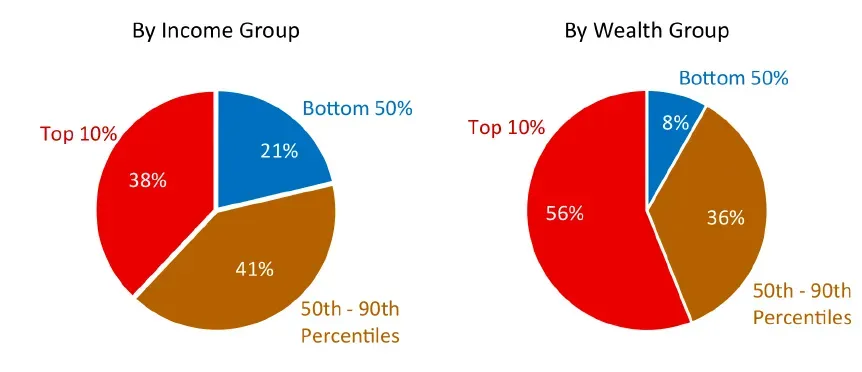Intergenerational wealth transfer in India marks a pivotal moment as the nation prepares for its most significant shift in financial legacy. A striking statistic surfaces in wealth transfer studies: up to 70% of family wealth diminishes by the second generation, and an alarming 90% is lost by the third. India’s burgeoning population of ultra-high-net-worth individuals (UHNIs)—set to increase by 58.4% by 2027—indicates the vast potential for wealth in transition. With a fresh influx of UHNIs emerging nearly every day as startups flourish, the stakes of effective wealth management strategies become increasingly vital. As trillions of rupees are set to flow from first-generation creators to their successors, understanding the dynamics behind family wealth loss becomes crucial for sustaining economic growth in India and preserving financial legacies for future generations.
The process of passing down wealth across generations—often referred to as generational wealth transfer—is becoming increasingly relevant in India’s rapidly expanding economy. As the number of ultra-wealthy families rises, so do concerns about the loss of inherited assets, which historically see a significant decline when handed down. The economic landscape is evolving, demanding refined wealth management approaches to combat family wealth loss and ensure sustainable growth. With diverse investments and the creation of family offices becoming common, navigating through these transitions is essential for preserving wealth and fostering ongoing prosperity. This shift signifies not just a change in ownership but also an opportunity to bolster economic growth in India as new strategies emerge to protect wealth for future generations.
Understanding Intergenerational Wealth Transfer in India
In recent years, India has been preparing for one of the most significant intergenerational wealth transfers in history. This process involves transferring considerable wealth from one generation to the next, often comprising family businesses, assets, and investments accumulated over the years. The study reveals that 70% of family wealth is lost by the second generation and a staggering 90% by the third, indicating the challenges heirs face in preserving their inherited wealth. Consequently, as India’s economy grows, the need for effective wealth management strategies becomes crucial.
The dynamics of intergenerational wealth transfer in India not only reflect cultural practices but also highlight the importance of financial education and strategic planning among heirs. As ultra-high-net-worth individuals (UHNIs) are on the rise, with projections indicating a growth of 58.4% by 2027, it becomes imperative for families to implement robust wealth management strategies to navigate complexities in asset preservation. Furthermore, understanding the statistics behind wealth transfer can help families prepare for potential losses and foster responsible financial stewardship in the next generation.
The Role of Ultra-High-Net-Worth Individuals in Wealth Transfer
The increase in the number of ultra-high-net-worth individuals (UHNIs) in India is reshaping the landscape of intergenerational wealth transfer. With estimates predicting their numbers will jump from 12,069 in 2022 to 19,119 in the coming years, these individuals represent a significant portion of India’s economic capacity. They are not just passive heirs but active participants who must be equipped with the marketing tools and knowledge of wealth management strategies to ensure their family legacies thrive.
UHNIs have unique investment opportunities and strategies that can impact how wealth is transferred across generations. For instance, they often engage in philanthropic ventures, creating foundations that not only cement their family’s legacy but also ensure that part of their wealth contributes positively to society. By focusing on wealth management, UHNIs can implement strategies that safeguard their assets from the common pitfalls of wealth loss, ensuring that future generations maintain and grow the family’s portfolio.
Wealth Transfer Statistics: A Call to Action for Indian Families
The statistics surrounding wealth transfer serve as a sobering reminder for families in India. With up to 70% of family wealth dissipating by the second generation, there is an urgent need for families to take action. This data should not only inform familial discussions about inheritance but also encourage families to proactively engage in financial planning and wealth management. By understanding these statistics, families can identify risks and better prepare their heirs to manage and preserve their wealth.
Moreover, financial literacy is paramount when it comes to wealth transfer. Many heirs may not be adequately prepared to handle vast sums of money or complex financial instruments. Therefore, families should prioritize educating their heirs about financial literacy, investment strategies, and the significance of preserving family wealth. By fostering a culture of financial awareness, families can diminish the likelihood of wealth loss across generations.
Economic Growth in India and Wealth Transfer Opportunities
India’s robust economic growth presents unprecedented opportunities for wealth transfer among families. With a significant percentage of the population becoming financially literate and entrepreneurial, family businesses and their succession planning are becoming urgent topics. The growing economy not only increases the pool of wealth available for transfer but also triggers discussions around investment strategies and the best approaches to safeguard assets for the future.
Additionally, as startups flourish and go public, more families find themselves in positions of substantial wealth. This economic progress creates a pressing need for wealth management strategies that cater to the complexities associated with rapid asset appreciation. Families must adapt their approaches to wealth transfer to align with economic realities and ensure the longevity of their financial legacies.
Strategies for Mitigating Family Wealth Loss
To combat the alarming statistics indicating high rates of family wealth loss, Indian families must employ strategic approaches tailored to their specific needs. Establishing educated investment practices, engaging in discussions on financial planning, and fostering a culture of transparency around wealth can make a marked difference. It is essential for families to work together to establish guidelines that protect their assets and ensure that each generation learns the importance of stewardship.
A wealth management strategy that includes family governance, investment diversification, and ongoing financial education can significantly mitigate wealth loss. Families should consider working with financial advisors who specialize in intergenerational wealth transfer to develop a comprehensive blueprint. By addressing family wealth preservation proactively, families can effectively navigate the challenges posed by generational wealth transfer.
The Importance of Financial Education for Heirs
Financial education is crucial for heirs who stand to inherit wealth. Given that many young individuals may lack the necessary skills or understanding of how to manage substantial financial assets, it is essential for families to approach financial literacy as a fundamental part of their wealth transfer strategy. By incorporating formal education programs or workshops focused on wealth management, families can empower their heirs with the knowledge and tools necessary to handle their inheritance responsibly.
Additionally, discussions about financial responsibility and investment decisions should start early in the process, often by involving heirs in financial planning and management from a young age. These proactive measures will not only prepare future generations to navigate the nuances of wealth but also enhance their ability to make informed decisions that align with family values and goals.
Navigating Family Business Succession
Family businesses are a core component of wealth in India, and ensuring a smooth succession plan is crucial for sustained economic growth and stability. Families must plan ahead for the transition of leadership and ownership within the family business, taking into consideration the unique dynamics that can arise with family dynamics. Succession planning not only involves choosing the right heir but also preparing them for leadership roles and defining crucial structures to retain value.
Effective communication and planning strategies are fundamental in navigating family business succession. Involving all family members in discussions about the future can prevent conflicts and misunderstandings down the line. Additionally, establishing a formal succession plan that includes mentorship, resources, and training for the next generation can ensure that the family business continues to thrive and contribute to the overall family wealth.
Adopting Technology for Wealth Management
In the modern age, technology plays a pivotal role in wealth management strategies. Financial technology solutions can simplify the wealth transfer process, offering families tools to monitor and manage their investments effectively. With various wealth management platforms available, families can track their assets, seek professional advice remotely, and easily engage with financial trends that impact their investments.
Moreover, technology provides an avenue for families to educate their heirs about financial management. Online courses and investment simulations can engage young family members, giving them practical experience and insights into managing wealth. By embracing technological advancements, families can enhance their strategic approach to wealth transfer, ensuring responsible investment across generations.
The Future of Wealth Transfer in India
As India approaches a significant shift in its wealth landscape, understanding the future of wealth transfer becomes paramount for families. With trillions of rupees set to exchange hands, the focus will need to shift toward sustainable wealth management practices and policies that ensure longevity. This shift encompasses not only the financial aspects but also the values that families wish to impart to their heirs.
Additionally, as India continues to integrate into global markets, families will need to adapt their wealth transfer strategies to account for international opportunities and challenges. This evolution signifies that families must remain vigilant in aligning their wealth management strategies with prevailing economic trends and global outlooks, ensuring that they safeguard their wealth for generations to come.
Frequently Asked Questions
What is the current trend in intergenerational wealth transfer in India?
India is witnessing a significant intergenerational wealth transfer, with trillions of rupees expected to transition from first-generation wealth creators to their heirs in the coming decades. This trend is fueled by the rapid growth of ultra-high-net-worth individuals (UHNIs), with their numbers projected to increase dramatically as India’s economy continues to expand.
How do wealth transfer statistics affect family wealth in India?
Wealth transfer statistics indicate that 70% of family wealth is lost by the second generation, and 90% by the third generation. This highlights the importance of effective wealth management strategies to preserve family wealth across generations, especially in the context of India’s upcoming wealth transfer.
What role do ultra-high-net-worth individuals play in India’s intergenerational wealth transfer?
Ultra-high-net-worth individuals (UHNIs) are pivotal to India’s intergenerational wealth transfer, as their numbers are expected to grow from 12,069 in 2022 to 19,119 by 2027. This surge among UHNIs contributes to the larger narrative of wealth accumulation and its eventual transfer to heirs.
What challenges does family wealth face during intergenerational transfer in India?
Family wealth in India faces challenges such as wealth management strategies that are inadequate in preventing the loss of assets across generations. Studies reveal a high percentage of family wealth loss, underlining the need for education and planning to secure financial legacies.
How is economic growth in India linked to intergenerational wealth transfer?
The economic growth in India is closely linked to intergenerational wealth transfer, as an increasing number of ultra-high-net-worth individuals are generated through successful startups and businesses. This growth not only enhances personal fortunes but also amplifies the scale of wealth changes as these resources are passed down.
What are effective wealth management strategies for intergenerational wealth preservation in India?
Effective wealth management strategies for preserving intergenerational wealth in India include diversified investments, estate planning, financial literacy for heirs, and establishing trusts. These approaches aim to mitigate the risk of family wealth loss that often occurs during transfers between generations.
What role does family businesses play in the intergenerational wealth transfer in India?
Family businesses are central to the intergenerational wealth transfer in India, as many wealthy families derive their fortunes from these enterprises. As ownership transitions to the next generation, it’s critical to implement structured governance and succession planning to maintain wealth integrity.
What impact does intergenerational wealth transfer have on societal economic growth in India?
Intergenerational wealth transfer has a profound impact on societal economic growth in India by facilitating investment in new ventures, enhancing consumer spending, and promoting philanthropic activities. As wealth is transitioned effectively, it contributes to the broader economic landscape and innovation.
| Key Points | Details |
|---|---|
| Significant Wealth Transfer | India is about to experience a major intergenerational wealth transfer. |
| Family Wealth Loss | 70% of family wealth is lost by the second generation and 90% by the third, according to global studies. |
| Increase in UHNIs | The number of ultra-high-net-worth individuals (UHNIs) in India is projected to rise by 58.4% from 2022 to 2027. |
| Daily UHNI Increase | Nearly three individuals become UHNIs every day due to startups going public. |
| Trillions at Stake | Trillions of rupees will change hands as wealth passes from first-generation creators to their heirs. |
Summary
Intergenerational wealth transfer in India is set to reach unprecedented levels as India’s economy thrives and the number of ultra-high-net-worth individuals grows significantly. With a statistic indicating that 70% of family wealth disappears by the second generation, this transition poses both challenges and opportunities. The expected transfer of vast sums will reshape the financial landscape and require careful planning and management to preserve wealth across generations.




